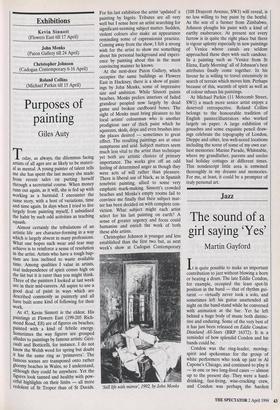Exhibitions
Kevin Sinnott (Flowers East till 17 April) John Monks (Paton Gallery till 24 April) Roland Collins (Michael Parkin till 15 April)
Purposes of painting
Giles Auty
Today, as always, the dilemmas facing artists of all ages are as likely to be maten- al as mental. A young painter of talent tells me she has spent the last money she made from recent sales on putting herself through a secretarial course. When money runs out again, as it will, she is fed up with working as a barmaid. I encounter the same story, with a host of variations, time and time again. In days when I tried to live largely from painting myself, I subsidised the habit by such odd activities as teaching squash.
Almost certainly the tribulations of an artistic life are character-forming in a way which is largely absent in many professions. What one hopes such wear and tear may achieve is to reinforce a sense of resolution In the artist. Artists who have a tough bap- tism are less inclined to waste available time. Among qualities I value in artists, real independence of spirit comes high on the list but it is rarer than you might think. Three of the painters I looked at last week are in their mid-careers. All aspire to use a good deal of paint in ways which are described commonly as painterly and all have built some kind of following for their work.
At 47, Kevin Sinnott is the eldest. His Paintings at Flowers East (199-205 Rich- mond Road, E8) are of figures on beaches, painted with a kind of febrile energy. Sometimes the way figures are grouped alludes to paintings by famous artists: Geri- cault and Botticelli, for instance. I do not know the Welsh word for spring but doubt It has the same ring as `primavera'. The famous scenes are transposed onto rather gloomy beaches in Wales, so I understand, although they could be anywhere. Yet the figures look tanned and healthy with pow- erful highlights on their limbs — all more redolent of St Tropez than of St Davids. For his last exhibition the artist 'updated' a painting by Ingres. Tributes are all very well but I sense here an artist searching for significant-seeming subject matter. Sudden, violent colours also make an appearance reminding some of expressionist practice. Coming away from the show, I felt a strong wish for the artist to show me something about his personal background and experi- ence by painting about this in the most convincing manner he knows.
At the next-door Paton Gallery, which occupies the same buildings as Flowers East in Hackney, there is a show of paint- ings by John Monks, some of impressive size and ambition. While Sinnott paints beaches, Monks prefers interiors of faded grandeur peopled now largely by dead game and broken cardboard boxes. The sight of Monks must bring pleasure to his local artists' colourman who is another prodigious user of thick paint which he squeezes, skids, drips and even brushes into the places desired — sometimes to great effect. The resulting paintings are at once sumptuous and arid. Subject matters seem much less vital to the artist than technique yet both are artistic choices of primary importance. The works give off an odd feeling of determined anger as though they were acts of will rather than pleasure. There is liberal use of black, as in Spanish tenebrist painting, allied to some very emphatic mark-making. Sinnott's crowded beaches and Monks's empty rooms fail to convince me finally that their subject mat- ter has been decided on with complete con- viction. What subject might each artist select for his last painting on earth? A sense of greater urgency and focus could humanise and enrich the work of both these able artists.
Christopher Johnson is younger and less established than the first two but, as next week's show at Cadogan Contemporary 'Still life with mirror; 1992, by John Monks (108 Drayc,ott Avenue, SW3) will reveal, is no less willing to buy paint by the boxful. As the son of a farmer from Zimbabwe, Johnson ploughs his paint with a kind of earthy exuberance. At present not every furrow is in quite the right place but there is vigour aplenty especially in new paintings of Venice whose canals are seldom approached these days with such candour. In a painting such as 'Venice from St Elena, Early Morning' all of Johnson's best attributes finally come together. In his favour he is willing to travel extensively in search of terrain which moves him. Perhaps because of this, warmth of spirit as well as of colour infuses his paintings.
At Michael Parkin (11 Motcomb Street, SW!) a much more senior artist enjoys a deserved retrospective. Roland Collins belongs to the honourable tradition of English painter/illustrators who worked largely on paper. A large exhibition of gouaches and some exquisite pencil draw- ings celebrate the topography of London, Dieppe and other, less well-noted locations including the scene of some of my own ear- liest memories: Marine Parade, Whitstable, where my grandfather, parents and uncles had holiday cottages at different times. This nondescript little area is entwined thoroughly in my dreams and memories. For me, at least, it could be a prompter of truly personal art.


























































 Previous page
Previous page